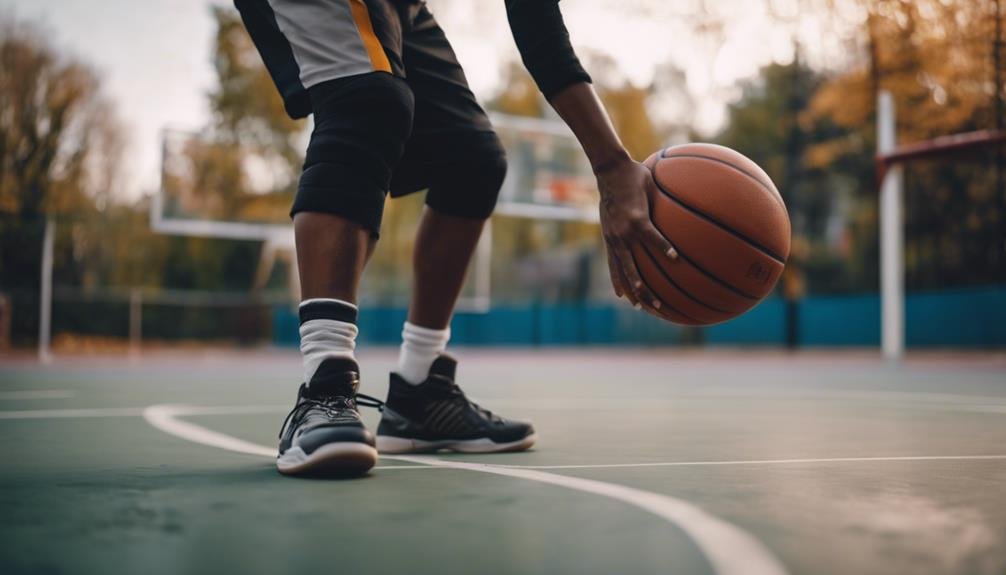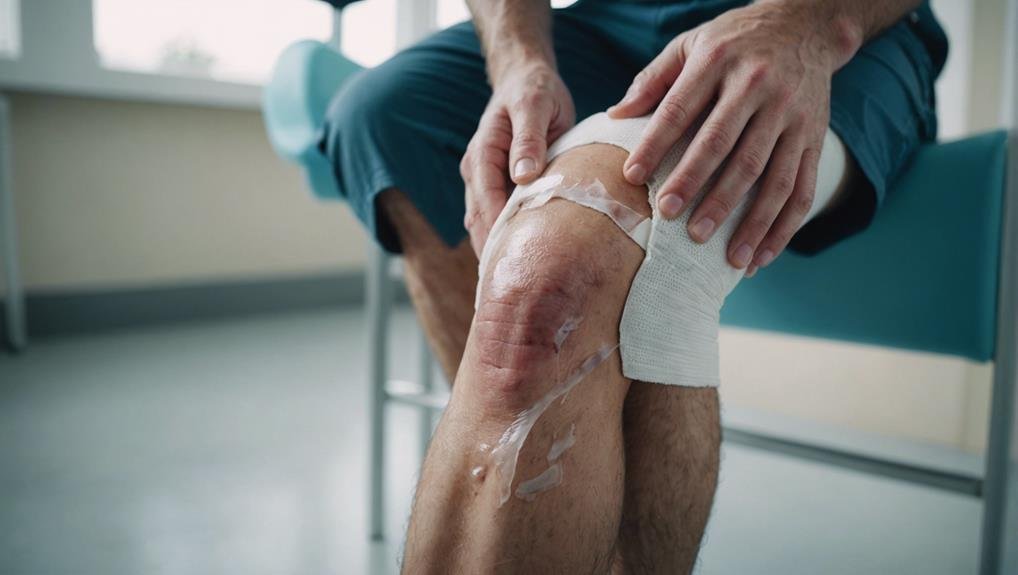When you experience a knee contusion, it’s often due to a direct hit to your knee, whether from a sports injury or an unexpected accident. You’ll notice immediate pain and swelling and likely see bruising that shifts in color as it heals. Managing the injury with the RICE protocol is initially essential, but what if these measures aren’t enough? Understanding when to seek medical attention and how to treat and prevent future contusions properly is important to your recovery and long-term knee health. Let’s explore the steps you need to take next.
Key Takeaways
- Knee contusions result from direct trauma, causing pain, swelling, and bruising.
- High-risk activities include contact sports like football, rugby, and soccer.
- Use the RICE protocol (Rest, Ice, Compression, Elevation) for initial treatment.
- Seek medical help if symptoms persist or worsen despite home treatment.
- Prevent knee contusions by using protective gear and strengthening leg muscles.
What Is a Knee Contusion?

A knee contusion is an injury where direct trauma to the knee damages muscle or bone tissue, causing pain and swelling. You might know it as a patellar contusion. When you sustain this injury, blood vessels in the affected area break, pooling blood under the skin. This pooling creates a visible bruise, typically dark purple or blue at first, gradually changing color as it heals.
The injury can result from various activities, especially in sports like football, rugby, and basketball, where blunt trauma is common. Symptoms of a knee contusion aren’t limited to visible bruising. You’ll likely experience pain and swelling, making it tough to move your knee as freely as usual. The severity of these symptoms depends on the extent of the injury.
The body’s natural response to a knee contusion involves inflammation and an influx of blood to the injured area, which helps begin the healing process. While minor contusions might heal within a few days with proper care, more severe injuries, especially those involving bone bruises, can take weeks or even months to recover fully.
Causes of Knee Contusions
Direct blows to the knee during sports activities or accidents often cause knee contusions. Playing sports like football, rugby, soccer, basketball, or lacrosse puts you at a higher risk of getting a bruised knee due to collisions, falls, or hitting your knee on hard surfaces. These sports involve a lot of physical contact and rapid movements, making them prime scenarios for a direct blow to your knee.
A bruised knee, also known as a contusion, happens when blunt trauma damages your knee’s soft tissues or bone. The impact from a direct blow can be forceful enough to rupture blood vessels, leading to the characteristic pain, swelling, and bruising.
Whether from a fall during a game or a hit from another player, a sports injury can be quite painful and may require some time to heal.
Accidents outside of sports can also cause knee contusions. For example, slipping on a wet floor or bumping your knee against furniture can lead to a similar injury. Regardless of how you get it, a knee contusion results from that impactful, often sudden, direct blow to your knee.
Common Symptoms

When you have a knee contusion, you’ll typically experience pain, stiffness, swelling, and difficulty bearing weight. These symptoms can make everyday activities challenging. The pain is often localized to the impact area and may worsen with movement.
Swelling occurs as the body responds to the injury, limiting the range of motion and making it difficult to bend or straighten the knee.
Another common symptom is bruising or ecchymosis. You might notice discoloration around your knee, ranging from a reddish hue to dark purple. This bruising is caused by blood vessels breaking under the skin.
Here’s a deeper look at what you might experience:
- Pain: Sharp or throbbing sensation, especially when moving or putting weight on the knee.
- Swelling: Noticeable puffiness around the knee can make it feel tight and restrict movement.
- Bruising: Skin discoloration around the knee, indicating bleeding under the skin.
- Stiffness: Difficulty bending or straightening the knee fully due to inflammation and swelling.
These symptoms usually develop shortly after the injury and can persist for several days or weeks, depending on the severity of the discoloration. Understanding these signs can help you manage your condition effectively.
When to Seek Medical Help
If your knee contusion doesn’t improve with home treatment or the pain and swelling worsen, seek medical help. Persistent or increasing pain and swelling are red flags that something more serious might be occurring.
You should also seek medical attention if you notice excessive bruising, have difficulty bearing weight on the affected leg, or if the discomfort doesn’t subside after a reasonable period.
A healthcare provider can evaluate your knee to determine the extent of the injury. They might order X-rays or an MRI to rule out fractures or other serious injuries that could be contributing to your pain and swelling. This imaging can help pinpoint the exact cause of your symptoms and guide the appropriate treatment plan.
Don’t delay seeking medical attention if your symptoms don’t improve or if you’re concerned about a possible fracture. Prompt evaluation by a doctor ensures you get the proper care and prevents potential complications.
Effective treatment can help you recover more quickly and safely. Remember, ignoring persistent symptoms can lead to more severe issues later, so it’s essential to take action when needed.
Initial Treatment Steps

The initial treatment for a knee contusion involves following the RICE protocol: Rest, Ice, Compression, and Elevation. You’ll want to give your knee a break from activities that could cause further damage. Resting helps reduce stress on the injured area and allows your body to heal.
Applying ice to your knee is essential. Do this for 15-20 minutes every 2-3 hours during the first 48 hours after the injury. Ice helps decrease swelling and numb the pain. Remember to wrap the ice pack in a cloth to prevent frostbite.
Another key step is compression. Use an elastic bandage to wrap your knee snugly but not so tight that it cuts off circulation. Compression can help limit swelling and provide support.
Lastly, elevate your knee above the level of your heart whenever you sit or lie down. This reduces inflammation and aids in quicker healing.
Here’s a quick checklist to guide you:
- Rest: Avoid activities that stress the knee.
- Ice: Apply for 15-20 minutes every 2-3 hours.
- Compression: Use an elastic bandage to reduce swelling.
- Elevation: Keep your knee above heart level.
Rehabilitation Exercises
After you’ve managed the initial treatment with the RICE protocol, it’s time to focus on rehabilitation exercises to restore strength and flexibility to your knee. Starting with gentle knee stretches, you can improve your range of motion and reduce stiffness. Stretching your hamstrings and calves will also support your knee’s recovery.
One essential exercise is the quad set. To perform a quad set, sit with your leg extended and tighten your thigh muscles, holding for a few seconds before releasing. This simple exercise helps rebuild the strength of your quadriceps, which is vital for knee stability.
As your knee begins to heal, you can gradually introduce more challenging exercises, such as hamstring curls and calf raises.
For hamstring curls, lie on your stomach, gently bring your heel towards your buttocks, and lower it back down.
Calf raises can be done by standing and lifting your heels off the ground, then slowly lowering them back down.
Preventing Knee Contusions

Protective gear, like knee pads, prevents knee contusions during physical activities. Knee pads provide a cushion that absorbs shocks and reduces the impact on your knees. This simple step can make a significant difference, especially if you’re involved in contact sports or activities with a high risk of falls.
In addition to wearing knee pads, regular strengthening exercises can help prevent knee contusions. Strengthening the muscles around the knee, such as the quadriceps and hamstrings, offers better support and stability to the joint, decreasing the likelihood of injuries.
Consider the following preventive measures:
- Use proper technique: Always use the correct form and techniques during physical activities to avoid direct impacts.
- Maintain a healthy weight: Keeping your weight in check reduces the strain and pressure on your knees.
- Gradually increase activity intensity: Avoid sudden increases in the intensity or duration of your workouts to prevent overuse injuries.
- Regularly use knee pads: Wear them during activities that pose a risk to your knees.
Conclusion
To conclude, dealing with a knee contusion requires attention and care. Don’t ignore persistent pain, swelling, or difficulty bearing weight—seek medical help if symptoms linger.
Stick to the RICE protocol initially and gradually introduce rehabilitation exercises to strengthen your knee.
Prevention is key: maintaining a healthy weight, wearing proper protective gear, and strengthening your leg muscles.
With the right approach, you can recover and get back to your activities safely.
FAQs
What is the best immediate treatment for a knee contusion?
The best immediate treatment for a knee contusion is the RICE protocol: Rest, Ice, Compression, and Elevation. Rest your knee to prevent further injury, apply ice for 15-20 minutes every 2-3 hours to reduce swelling, use an elastic bandage for compression, and elevate your knee above heart level to minimize inflammation.
When should I seek medical attention for a knee contusion?
Seek medical attention if your knee contusion doesn’t improve with home treatment, the pain and swelling worsen, or you have difficulty bearing weight on the affected leg. Persistent or increasing symptoms may indicate a more serious injury, such as a fracture, requiring professional evaluation and treatment.
How can I prevent future knee contusions?
Wear protective gear like knee pads during high-risk activities, maintain a healthy weight, and regularly perform leg muscle-strengthening exercises to prevent future knee contusions. Proper techniques and gradually increasing the intensity of physical activities can also help reduce the risk of knee injuries.

